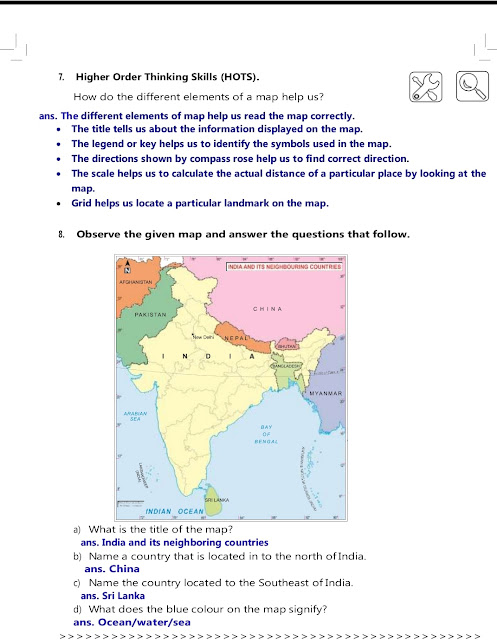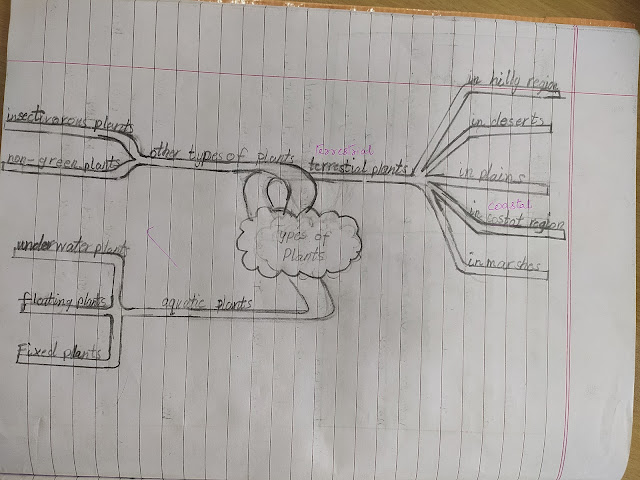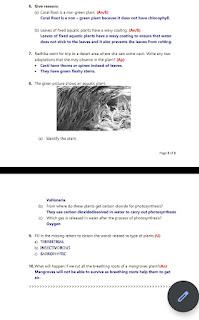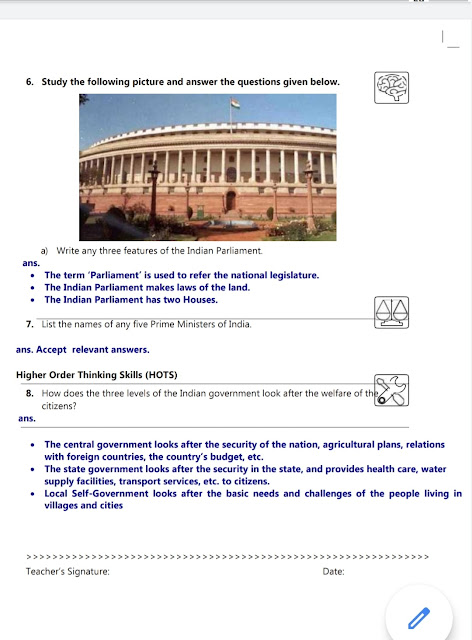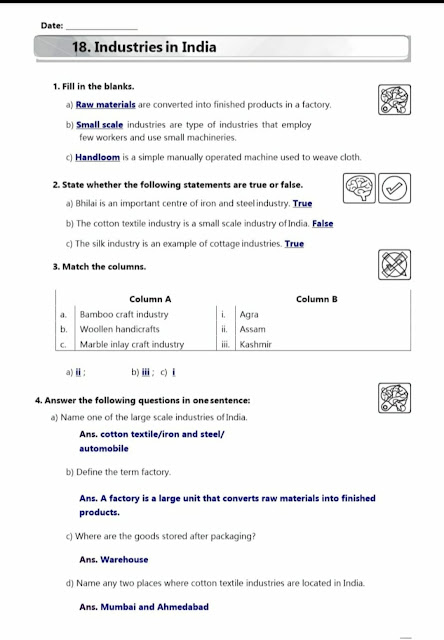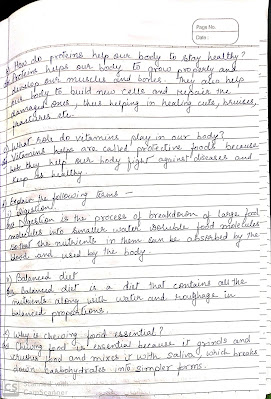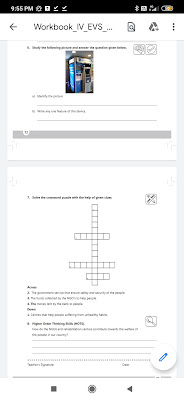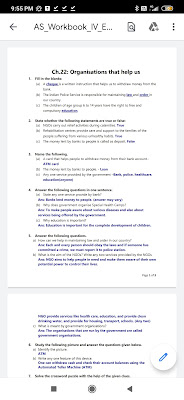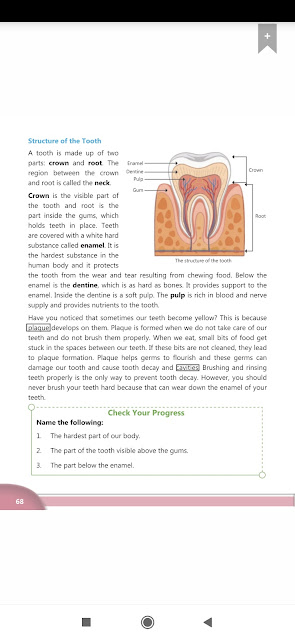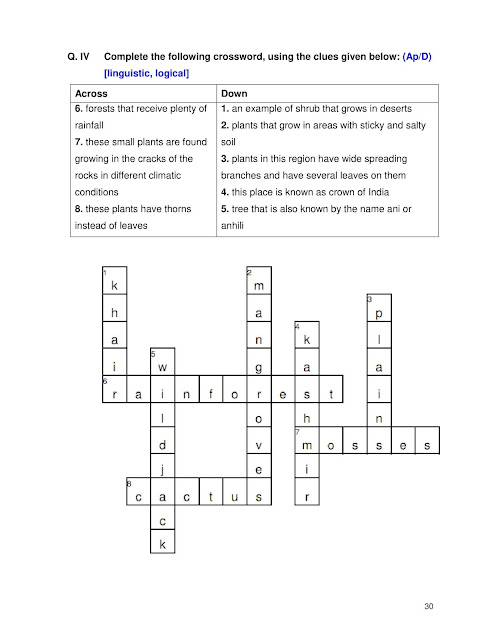 |
Workbook Answer Scheme of Plants make Food
Workbook of Types of Plants
Chapter 5 Types of Plants
I
PODAR INTERNATIONAL SCHOOL
Weekly
test Paper
Subject-EVS STD-4 Total marks- 15m
A. Fill in the blanks: -
2 1/2m
a. The Panchayat Samiti is the government at
__________ level.
b. Fuels have __________ energy locked in
them.
c. The law making body is the legislature known
as the ____________.
d. ____________ energy helps us to hear.
e. ___________ is the natural source of
energy.
B.
Write True or False :-
2 1/2m
a.
The state government looks after the individual state.
b.
Plants use wind energy to make food in the green leaves.
c.
The Prime Minister is more powerful and leader of the Government.
d.
Fuels when burnt release energy.
e.
Any object that moves have no energy in it.
C.
Name the following:-
4x1m
a.
Government at the district level.
b.
The energy that we get from the Earth
c.
The process of choosing leaders
d.
The local self government at the smaller cities
D.
Answer the following questions:-
3x2=6m
a.
What is democracy? What is the age criterion to vote for an Indian citizen?
b.
Why do we use energy? How can we help our body to regain the energy that is
used?
c.
Whom does Central Government look after? Why does Prime Minister select his
council of ministers?
PODAR
INTERNATIONAL SCHOOL,MEHSANA
STD:-IV SUB:EVS CH:WORK AND ENERGY WORKSHEET
Q-1) Fill in
the blanks.
a) Fuels have
__________energy locked in them.
b) Fuels are
_________ substances that have energy stored in them.
c) The
energy from moving water is used to produce __________ energy.
d) Food has
energy stored in ___________ form.
e)
___________ energy helps you to hear.
Q-2) Define the following.
a) Work
b) Energy
c) Geo
thermal energy
Q-3)Answer
the following questions.
a) How much
of Earth’s surface is covered with water?
b) Write the
uses of Fuels.(coal,petroleum,oil,wood)
c) What is
the meaning of interior of Earth?
d) Write
applications of solar energy.
PODAR INTERNATIONAL SCHOOL
Subject-EVS STD-4 Topic- Force
A. Fill in the blanks:-
a. When a object is moved towards another
object it is called pull.
b. Force can make an object at rest move.
c. Friction is more on a rough surface than on
a smooth surface.
d. The force exerted by an Earth on all the
objects is called gravitational force.
e. Muscular force is applied through muscles.
B.
Write true or false :-
a.
Force cannot change the shape of an object. False
b.
To lift a box of apples we use muscular force. True
c.
Water falls down from the tap due to elastic force. False
d.
The force of friction allows moving object to slow down or stops moving. True
e.
All the material eventually fell to the ground when thrown upwards. True
C.
Give reasons:-
a.
Fruit fall down from a tree onto the ground and not move upwards in the air.
Ans
. Fruits fall down from a tree onto the ground and not move upwards in the air
due to the gravitational force of the Earth.
b.
The rubber bands changes their shape when they are stretched and regain it when
they are released.
Ans. The rubber band changes their shape when they
are stretched and regain it again due to elastic force.
c.
When the pencil box was gently pushed, it slid for some distance and stopped.
Ans.
When the pencil box was gently pushed, it slid for some distance and stopped
due to frictional force.
D.
Answer the following question:-
a.
Write the difference between muscular force and gravitational force.
Ans. Muscular force is a force applied using
parts of the body such as arms and legs whereas gravitational force is the
force exerted by the Earth on all the objects.
b.
What is frictional force? Give one example of frictional force in our daily
life.
Ans.
Frictional force is a force exerted by a surface as an object moves across
it.
For
example- to be written by students themselves
E.
Observe the following pictures and identify if it is push or pull
a.
Pull
b. Pull


c. Push 

d.Push e. Pull
. 



PODAR
INTERNATIONAL SCHOOL,MEHSANA
WORKSHEET
STD:- IV SUB:- EVS
CH:
GOVERNMENT
Q-1) Fill in the blanks.
a) The process
of choosing leaders is known election.
b) The law
making body is the legislature known as parliament.
c) The
Governor is the highest authority in state.
d) All Indians
citizens who have completed 18 years of ages can their leader.
e) State government
looks after individual state.
Q-2) Write true or false.
a) President
is the head of state. [ false ]
b) The
Panchayat Samiti is the government at district level.[ false ]
c) The local
self government body at bigger cities is known as municipal corporation.[ true
]
d) Central
government looks after the entire country.[true]
Q-3) Name the following.
a) The
government at village level.ans: Village panchayat
b) Government
at block level.ans:Panchayat samiti
c) Government
at district level.ans: Zilla parishad
d) Local self
government body at the smaller cities and towns.ans: Municipalities
Q-4) Answer the following
questions.
a) Define
democracy.
Ans: A
government of the people ,by the people and for the people is called democracy.
b) What do you
understand by a session?
Ans:-The
period during which two houses conduct meetings is called session.
c) State the
composition of central government .
Ans: The
central government consists of President,the vice president and the council of
ministers headed by the Prime minister.
d) Who is the
highest authority in state?
Ans: Governor
is the highest authority in state.
e) What is
municipality?
Ans:The
local self-government body at smaller cities and towns is known as
Municipality.
f) Name the
two houses of Indian parliament.
Ans: The
two houses of Indian parliament are Lok sabha and Rajya sabha.
g) What is the
government at district level known as?
Ans:The
Zilla parishad is the government at the distrct level.
PODAR INTERNATIONAL SCHOOL
Subject-EVS STD-4 Topic- Industries in India
A.
Fill in the blanks:-
a.
Raw material is provided by nature
b.
We have three types of industries.
c.
The process of converting raw materials into finished goods is known as
manufacturing.
d.
Handloom is an example of Cottage industry.
e.
Shipping is one of the large scale
industries in Mumbai.
B.
Write True or False:-
a.
Raw materials are sent to factories for processing. True
b.
The finished goods are packaged and sent to the warehouses. True
c.
Fruits and vegetables are finished goods. False
d.
Worker does manual labour and get paid for his work. True
e.
Thousands of people are employed in cottage industry. False
C.
Answer the following questions:
a.
Name two important industries found in India with their location.
Ans.
Automobile manufacturing in Gurgaon, Jamshedpur, Nashik
b.
Differentiate between cottage and small scale industries with examples.
Ans.
Cottage industries are industries where people make different things in their
own homes by employing very few people. For example-
Whereas
small scale industries are industries that employ more people as compared to
cottage industry. For example
c.
What are large scale industries? Give examples
Ans.
Large scale industries are those industries that employ thousands of people and
use large machines to produce large quantities of finished goods using huge
amount of raw materials. For example – Iron
and Steel, Automobile etc
d.
How are goods processed?
Ans.
At first the raw materials are collected from the farms and sent to the
factories for processing. Then goods are manufactured with the help of these
raw materials and finished goods are packaged and sent to the warehouse to be
transported to different parts of the country. Finally, the manufactured goods
reach the malls.
e.
Why is tea bushes kept waist high in height? Name two states where tea is
cultivated.
Ans.
Tea bushes are hand picked and to make plucking task easier tea bushes are kept
waist high in height. The two states
where tea is cultivated are Assam and Darjeeling
WORKSHEET
STD:- IV SUB:- EVS CH: GOVERNMENT
Q-1) Fill in the blanks.
- The process of choosing leaders is known ________.
- The law making body is the legislature known as ______.
- The __________ is the highest authority in state.
- All Indians citizens who have completed ________ years of ages can their leader.
- State government looks after_________.
Q-2) Write true or false.
- President is the head of state.
- The Panchayat Samiti is the government at district level.
- The local self government body at bigger cities is known as municipal corporation.
- Central government looks after the entire country.
Q-3) Name the following.
- The government at village level.
- Government at block level.
- Government at district level.
- Local self government body at the smaller cities and towns.
Q-4) Answer the following questions.
- Define democracy.
- What do you understand by a session?
- State the composition of central government .
- Who is the highest authority in state?
- What is municipality?
- Name the two houses of Indian parliament.
- What is the government at district level known as ?
PODAR INTERNATIONAL SCHOOL
Subject-EVS STD-4 Topic- Industries in India
A. Fill in the blanks:-
a. Raw material is provided by _________.
b. We have ________ types of industries.
c. The process of converting raw materials into finished goods is known as __________.
d. Handloom is an example of _____________ industry.
e. ____________ is one of the large scale industries in Mumbai.
B. Write True or False:-
a. Raw materials are sent to factories for processing.
b. The finished goods are packaged and sent to the warehouses
c. Fruits and vegetables are finished goods.
d. Worker does manual labour and get paid for his work.
e. Thousands of people are employed in cottage industry.
C. Answer the following questions:
a. Name two important industries found in India with their location.
b. Differentiate between cottage and small scale industries with examples.
c. What are large scale industries? Give examples
d. How are goods processed in an industry?
e. Why is tea bushes kept waist high in height? Name two states where tea is cultivated.
PODAR INTERNATIONAL SCHOOL
Subject-EVS STD-4 Topic- Plants make food
A. Fill in the blanks:-
a. During the process of photosynthesis oxygen is given out.
b. Carbondioxide gas is released during the process of respiration.
c. Glucose is formed during the process of photosynthesis.
d. At night plants close the stomata and the process of food making stops.
e. If the soil is dry the rate of photosynthesis will decrease.
B. Write True or False:-
a. Sun is the source of light energy for the plants. True
b. All living things make their own food. False
c. Chlorophyll is present in roots of the plant. False
d. Like living beings plants also breathe in oxygen and breathe out carbondioxide. True
e. Oxygen gas is taken in during the process of respiration. True
C. Give reasons:-
a. Plants cannot make their food at night.
Ans. Plants cannot make their food at night due to the non availability of sunlight
b. We must not sleep under a tree at night.
Ans. We must not sleep under a tree at night because plants release excess carbondioxide at night which is harmful for human beings.
D. Name the following:-
a. The green pigment present in leaves
Ans. Chlorophyll
b. The part of plant that absorbs water.
Ans. Root
c. The form in which food is formed during photosynthesis.
Ans. Starch
d. The gas that is given out in the process of photosynthesis.
Ans. Oxygen
E. Answer the following questions:-
a. What do you mean by germination?
Ans. Germination is the process by which a seed starts growing or developing into a new plant.
b. Why are plants called producers?
Ans. Plants are the only living organisms that can prepare their own food and all other living organisms depend on plants directly or indirectly for their food. That is why plants are called producers.
c. What does the plant do with the unutilised foods?
Ans. The unutilised foods are stored in the form of starch in different parts of the plants such as roots, stems, leaves, fruit and flowers.
d. How do carbondioxide present in the air enters the leaves?
Ans. Carbondioxide present in the air enters the leaves through pores on their surface.
e. What will happen to the rate of photosynthesis if there is less sunlight?
Ans. If there is less sunlight the rate of photosynthesis will decrease.
f. Write the comparison between photosynthesis and respiration.
Ans. During the process of photosynthesis the carbon dioxide gas is taken in and oxygen gas is given out while during the process of respiration oxygen gas is taken in and carbon dioxide gas is given out.
g. What does a leaf require to prepare food for the plant?
Ans. A leaf requires water, sunlight and carbondioxide to prepare food for the plant.
h. Complete this equation:
Carbondioxide + Water in the presence of sunlight Oxygen + Glucose
Chlorophyll
PODAR INTERNATIONAL SCHOOL
Subject-EVS STD-4 Topic- Plants make food
A. Fill in the blanks:-
a. During the process of _______________ oxygen is given out.
b. ______________ gas is released during the process of respiration.
c. ___________ is formed during the process of photosynthesis.
d. At ________ plants close the stomata and the process of food making stops.
e. If the soil is dry the rate of photosynthesis will ____________.
B. Write True or False:-
a. Sun is the source of light energy for the plants.
b. All living things make their own food.
c. Chlorophyll is present in roots of the plant.
d. Like living beings plants also breathe in oxygen and breathe out carbondioxide.
e. Oxygen gas is taken in during the process of respiration.
C. Give reasons:-
a. Plants cannot make their food at night.
b. We must not sleep under a tree at night.
D. Name the following:-
a. The green pigment present in leaves
b. The part of plant that absorbs water.
c. The form in which food is formed during photosynthesis.
d. The gas that is given out in the process of photosynthesis.
E. Answer the following questions:-
a. What do you mean by germination?
b. Why are plants called producers?
c. What does the plant do with the unutilised food?
d. How do carbondioxide enters the leaves?
e. What will happen to the rate of photosynthesis if there is less sunlight?
f. Write the comparison between photosynthesis and respiration.
g. What does a leaf require to prepare food for the plant?
h. Complete this equation:
Carbondioxide + Water in the presence of sunlight Oxygen + __________
Chlorophyll PODAR INTERNATIONAL SCHOOL
Subject-EVS STD-4 Topic- Agriculture in India
A. Fill in the blanks:-
a. Groundnut oil is the staple oil used by the people of western part of
India.
b. Farmer is a person who cultivates crop.
c. The farmer sows the Kharif seeds in the monsoon season.
d. Rajasthan is the largest producer of bajra in India
e. Green Revolution was introduced in 1968.
B. Write True or False:-
a. Jute is a food crop. False
b. India is the largest producer of millets in the world. True
c. Crops are grown only for the purpose of food. False
d. Hot and humid climate is favourable for cultivating tea. True
e. Organic farming protects fertility of soil. True
C. Give reasons:-
a. Rajasthan is the largest producer of bajra in India.
b. Tea plant needs running water for its growth.
D. Name the following:-
a. Two cash crops
Ans. Jute and cotton
b. Two rabi crops
Ans. Wheat and Peas
c. Two oilseeds
Ans. Mustard and Sesame
d. Two cotton cultivating states
Ans. Gujarat and Maharashtra
e. Two coarse food grains.
Ans. Jowar and Ragi
f. The golden fibre
Ans. Jute
E. Answer the following questions:-
a. Write two key characteristics of organic farming.
Ans. The key characteristics of organic farming are:-
- Protecting fertility of soils
- Control weed, diseases and pest by crop rotations, organic manuring, planting resistant varieties and minimal chemical intervention.
b. What type of climate is favourable for cultivating sugarcane? Name two
sugarcane producing states.
Ans. High temperature with high rainfall is favourable for cultivating sugarcane. The two sugar producing states are Uttar Pradesh and Haryana.
c. Why is water essential for crops? What are the sources of irrigation?
Ans. Water is essential for the germination of the crops. The sources of irrigation are tube wells, hand pump, wells, pond, rivers, lakes, dams and canals.
d. What is the favourable climate to grow rice crop? In which soil does it grow?
Ans. Rice is mainly grown in rain fed areas that receive heavy annual rainfall. It grows in hot and humid climate. Fertile alluvial soil is favourable for cultivating rice.
PODAR INTERNATIONAL SCHOOL
Subject-EVS STD-4 Topic- Agriculture in India
A. Fill in the blanks:-
a. ____________ oil is the staple oil used by the people of western part of
India.
b. __________ is a person who cultivates crop.
c. The farmer sows the ____________ seeds in the monsoon season.
d. _________ is the largest producer of bajra in India
e. _________ Revolution was introduced in 1968.
B. Write True or False:-
a. Jute is a food crop.__________
b. India is the largest producer of millets in the world._______
c. Crops are grown only for the purpose of food._______
d. Hot and humid climate is favourable for cultivating tea._________
e. Organic farming protects fertility of soil.___________
C. Give reasons:-
a. Rajasthan is the largest producer of bajra in India.
b. Tea plant needs running water for its growth.
C. Name the following:-
a. Two cash crops
b. Two rabi crops
c. Two oilseeds
d. Two cotton cultivating states
e. Two coarse food grains.
f. The golden fibre
D. Answer the following questions:-
a. Write two key characteristics of organic farming.
b. What type of climate is favourable for cultivating sugarcane? Name two
sugarcane producing states.
c. Why is water essential for crops? What are the sources of irrigation?
d. What is the favourable climate to grow rice crop? In which soil does it grow?


PODAR INTERNATIONAL SCHOOL
Subject-EVS STD-4 Total
marks-15
A. Fill in the blanks:-
2m
a. Plants growing in hot deserts can store
water in their fleshy stems.
b. Lala Lajpat Rai was also called Punjab
Kesari.
c. The pitcher plant is a carnivorous plant.
d. Maharana Pratap was the Rajput ruler of
Mewar.
B.
Write True or False:-
2m
a.
Babur was a Maratha ruler. False
b.
Raja Ram Mohan Roy opposed the practice of Sati. True
c.
Neem tree grows in cold region. False
d.
Plants of plains have thick trunks. True
C.
Give reasons:-
3m
a.
Leaves of trees growing in rainforest have drip tip.
Ans.
So that the rain drops run off quickly.
b.
Plants of cold region have needle shaped leaves.
Ans. Because it protects them from extreme cold.
c.
A large variety of plants are found growing in plains.
Ans.
Because plains are considered to be more fertile.
D.
Answer the following questions:-
8m
a.
When did medieval period of Indian History begin?
Ans.
Medieval period begins with the invasion of Mahmud of Ghazni.
b.
Name two plants that are found growing in the cracks of rocks.
Ans.
Ferns and mosses are found growing in the cracks of rocks.
c.
Why do plants such as cactus have thorn instead of leaves?
Ans.
Leaves lose lots of water, so cactus have thorns instead of leaves to
reduce water loss
d.
Write two properties of solid matter.
Ans.
1. Solid is rigid
2. Solid has fixed shape and volume

PODAR INTERNATIONAL SCHOOL
Subject-EVS STD-4 Total
marks-15
A. Fill in the blanks:-
2m
a. Plants growing in hot deserts can store
water in their ________ stems.
b. Lala Lajpat Rai was also called Punjab
_____________.
c. The pitcher plant is a _______________
plant.
d. Maharana Pratap was the Rajput ruler of
_________.
B.
Write True or False:-
2m
a.
Babur was a Maratha ruler.__________
b.
Raja Ram Mohan Roy opposed the practice of Sati._______
c.
Neem tree grows in cold region._______
d.
Plants of plains have thick trunks._________
C.
Give reasons:-
3m
a.
Leaves of trees growing in rainforest have drip tip.
b.
Plants of cold region have needle shaped leaves.
c.
A large variety of plants are found growing in plains.
D.
Answer the following questions:-
8m
a.
When did medieval period of Indian History begin?
b.
Name two plants that are found growing in the cracks of rocks.
c.
Why do plants such as cactus have thorn instead of leaves?
d.
Write two properties of solid matter.





































